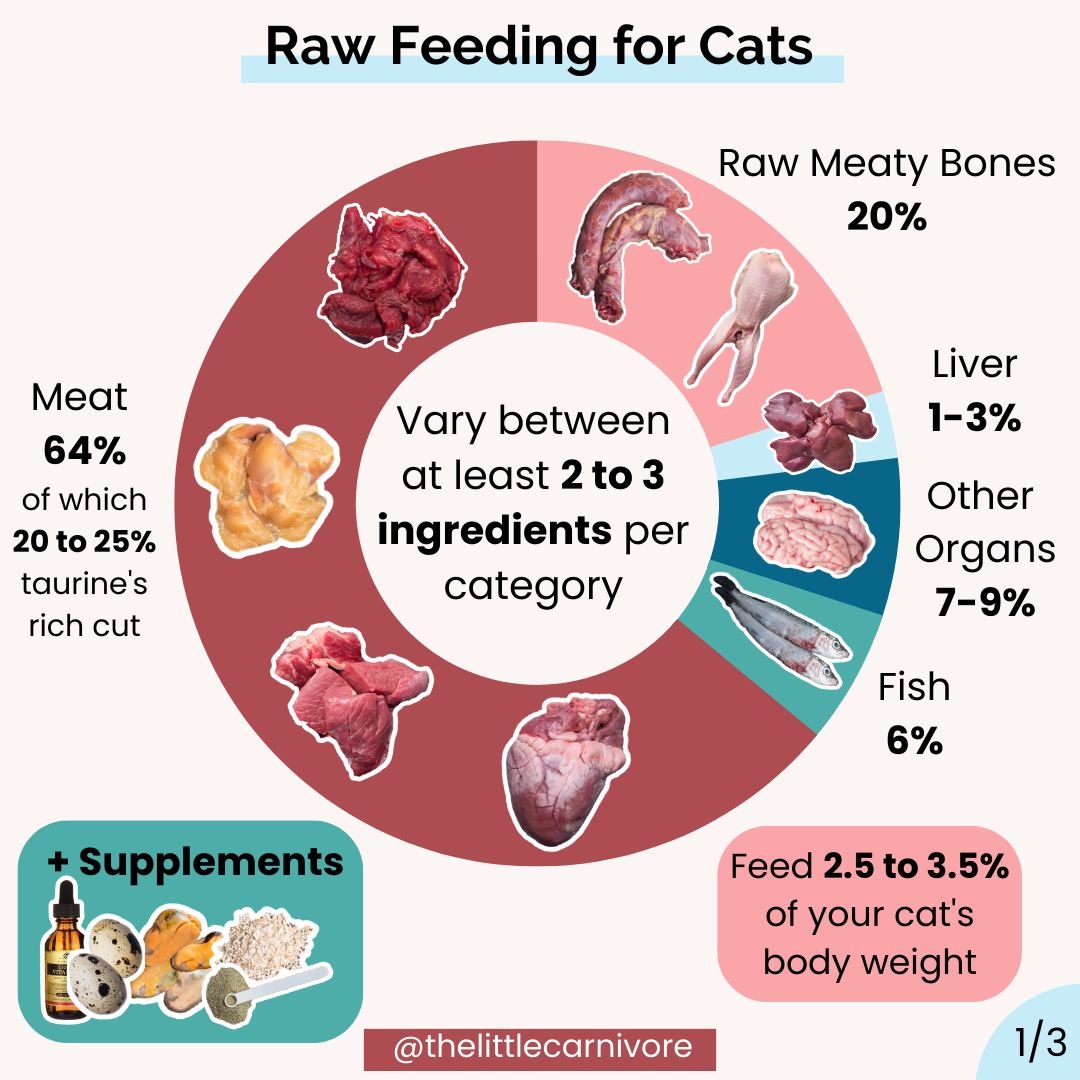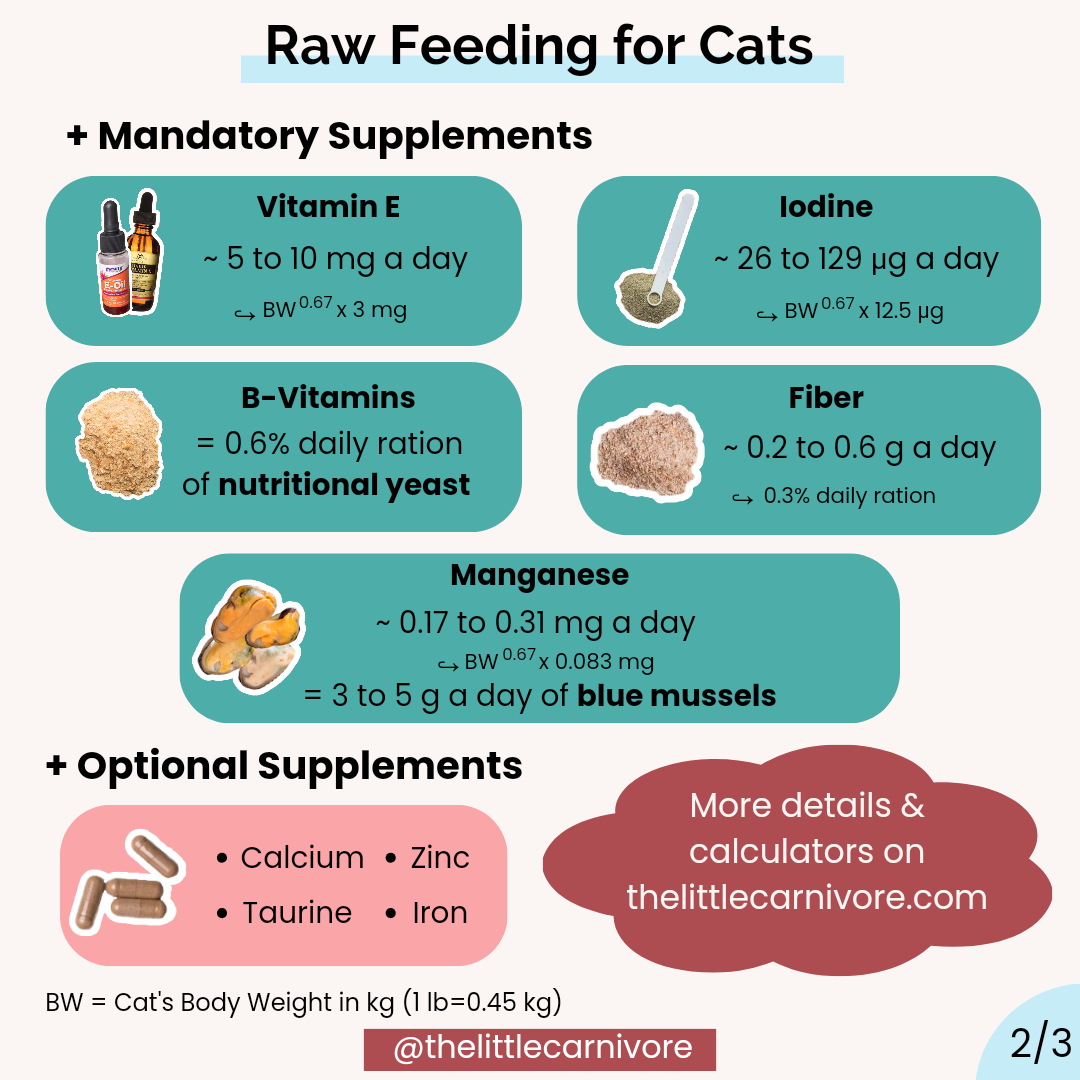Calculator: raw diet for cats
In previous articles, we discussed the Prey Model Raw diet—a popular way to balance a raw diet—and its flaws as it’s not enough to provide a balanced diet. I also presented an improved way to feed a Prey Model Raw diet: the PMR+ which is simply a Prey Model diet adapted to better fit the nutritional requirements of cats as defined by the NRC.
In this article, you will find my take, as a feline nutritionist, on PMR+ as well as a calculator to help you get started with raw feeding.
The ingredients
Meat
Muscle meat is the main part of the diet, accounting for 64% of it. You should vary between at least 3 different meat types and feed around half of the meat as red meat.
For more details on which meat can be fed raw or not, refer to this article on muscle meat.
Be mindful of the fat content of the meat you are feeding, as a high-fat diet may not provide enough protein for your cat. You should aim for 30% to 40-45% of the calories as fat, which means that you should feed meat containing around 5% to 10% fat as fed.
Heart
While it's not mandatory, as part of the meat it’s highly recommended to feed up to 20% of heart and other taurine-rich organs such as tongue, lung, and gizzards.
Raw Meaty Bones
Raw meaty bones should account for 20% of the diet. Raw meaty bones are essential as a source of calcium in the diet. Similarly to the meat, you should vary between 2-3 sources of bones for your cat. You can find more details on which kind of raw meaty bones you can feed in this article.
Generally, in a PMR diet, you will see the recommendation of 6% to 10% of edible bones. In this calculator, for the sake of simplicity, I consider both the bone and the meat around it and not only the edible bone part.
Liver
Liver should be around 1% to 3% of the diet. Feed the lower percentage for ruminants (like beef, lamb, veal) and duck liver as they are richer in vitamin A and copper than other liver.
You should vary between 2-3 different types of liver. However, you can’t feed exclusively chicken and pork liver as they don’t provide enough copper.
The traditional recommendation of feeding 5% liver in a Prey Model diet is too high and will provide unnecessary high levels of vitamin A and copper. The Prey Model diet is supposedly based on the recreation of prey. However, anatomically the liver represents only 2% to 3% of the body weight of omnivores and 1% to 1.5% of the body weight of herbivores. [1]
Other organs
Other organs such as kidney, spleen, brain… should be around 7% to 9% of the diet. As for the other ingredients, you should vary between organ types as well as animals.
Fish
Fish should be around 6% of the diet. While fish is not originally in the Prey Model raw diet, it’s difficult to fulfill the vitamin D requirements as well as omega-3 without it. I recommend feeding small oily fish as they are rich in vitamin D and omega-3 while being lower in heavy metals than other fish. Raw fish should be frozen for at least a week before feeding it.
Supplements
Some supplements are almost always needed and you can read more about them in my articles on manganese, iodine, fiber, vitamin E, and nutritional yeast.
Some other supplements may not always be necessary depending on the meat you are feeding: iron, zinc, and taurine. You will find more details on when they are necessary in these articles. Here is a quick summary:
Iron: If you don’t feed spleen regularly, there's a risk of iron deficiency.
Zinc: If you don’t feed lean beef regularly, there's a risk of zinc deficiency.
Taurine: It’s better to add taurine when you feed ground meat, or large quantities of rabbit and poultry breast.
Finally, I added in the calculator a calcium carbonate supplement to improve the ratio calcium:phosphorus. The “ideal” calcium:phosphorus ratio is between 1 and 1.5. However, with raw meaty bones, the ratio is generally between 0.6 to 0.9. While the NRC considers that a ratio between 0.5 to 1.5 is acceptable, if you want an “ideal” diet I would recommend adding calcium carbonate to improve the ratio.
It’s very important to note that this amount of calcium cannot replace raw meaty bones if you can’t feed them.
Note on supplements
You can use other brands or dosages of supplements than the ones in the calculator, as it’s not an exhaustive list.
If you get a recommendation such as feeding 0.1 capsules a day (3 capsules a month), do not feed one capsule every 10 days. I would rather suggest making a supplement mix to easily divide capsules for several days.
Disclaimer
The recommendation and the calculator in this article are based on my experience as a feline nutritionist formulating balanced diets according to the NRC standard. However, this calculator doesn’t guarantee that you'll feed a balanced diet: it can be used as a starting point to then tailor a diet to your cat's specific needs.
I highly suggest that you use it as a base and that you keep learning about feline nutrition. You can also audit your cat’s diet using spreadsheets such as the one from Raw Fed and Nerdy or Paws of Prey.
This calculator is made for healthy adult cats only. It is not adapted for kittens, older cats, lactating or pregnant queens, or cats with diseases.
Here are other cases in which the calculator won’t be adapted:
Your cat can’t eat bones.
You can’t find a big variety of meat or organs.
Your cat is very overweight or underweight.
Your cat has particularly high or low energy requirements (for example hairless cats).
If you are in any of these cases and need help feeding your cat a raw diet, you can find my recipe formulation services here.
| Total ration | 0 g |
| Meat | 0 g |
| Raw Meaty Bones | 0 g |
| Liver | 0 g |
| Other Organs | 0 g |
| Fish | 0 g |
| Supplements | |
| Manganese |
Estimated Missing Amount
0
mg
Supplement estimation
|
| Iodine |
Estimated Missing Amount
0
μg
Supplement estimation
|
| Fiber |
Estimated Missing Amount
0
g
Supplement estimation
|
| Vitamin E |
Estimated Missing Amount
0
mg
Supplement estimation
|
| B vitamins |
Supplement estimation
0
|
| Optional Supplements | |
| Iron |
Estimated Missing Amount
0
mg
Supplement estimation
|
| Zinc |
Estimated Missing Amount
0
mg
Supplement estimation
|
| Calcium |
Supplement estimation
0
|
| Taurine |
Estimated Missing Amount
0
mg
Supplement estimation
|
Want to support The Little Carnivore?
As you may have noticed, The Little Carnivore is ad-free! Creating quality content takes time and money.
If you want to support me but are not interested in my custom nutrition services you can donate here.
Thank you!
Sources
[1] Singh, Baljit, et al. Dyce, Sack, and Wensing’s Textbook of Veterinary Anatomy. Fifth edition, Elsevier, 2018.
Manganese: based on metabolic weight formula, assuming that 30% of the recommended allowance (0.119mg per kg/BW^0.67) is already covered by the diet.
Iodine: based on metabolic weight formula (12.5μg per kg/BW^0.67).
Fiber: based on 1% fiber on a dry matter basis.
Vitamin E: based on metabolic weight formula for high PUFA diet (3mg per kg/BW^0.67)
B vitamins: the nutritional yeast recommendation is based on 0.6% of the diet.
Iron: based on metabolic weight formula assuming that 60% of the recommended allowance (1.98mg per kg/BW^0.67) is already covered by the diet.
Zinc: based on metabolic weight formula assuming that 60% of the recommended allowance (1.90 mg per kg/BW^0.67) is already covered by the diet.
Calcium: the calcium carbonate recommendation is based on 0.4% of the diet.
Taurine: based on metabolic weight formula with the recommended allowance for dry diets (24.75mg per kg/BW^0.67).
The link to the Paws of Prey spreadsheet is an affiliate link: I may earn a small commission at no extra cost to you. Thank you for your support!


